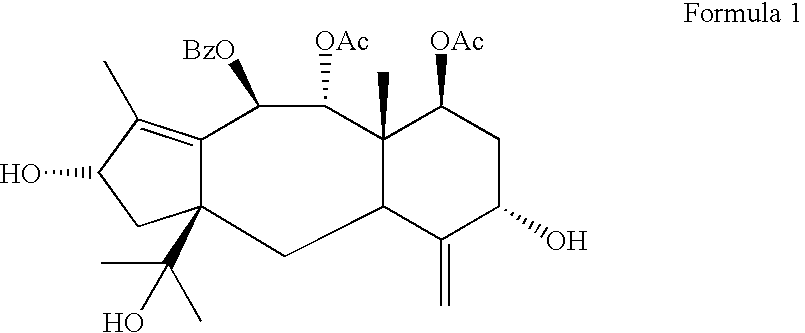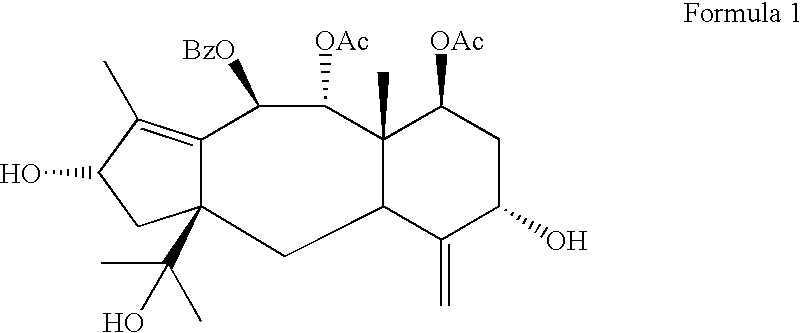Process for preparing brevifoliol
a technology of brevifoliol and brevifolium, which is applied in the field of brevifoliol preparation process, can solve the problems of inconvenient processing, cumbersome, laborious, etc., and achieve the effect of high yield
- Summary
- Abstract
- Description
- Claims
- Application Information
AI Technical Summary
Benefits of technology
Problems solved by technology
Method used
Image
Examples
example 1
[0056] Airdried and pulverized leaves of the plant Taxus wallichiana (3 kgs) were extracted with MeOH (9 lit. times .3) at 20-40° C.) for three days. MeOH was concentrated under vacuum and the MeOH ext.was adsorbed with celite (800 g) and the adsorbed material was dried at 20-50° C. for 4-48 hours. The dried adsorbed material was then extracted with petroleum ether (60-80° C.) (3 lit. times 3) and chloroform (3 lit. times.3) successively. Chloroform extract (80 g) was concentrated under vacuum to a residue and was fractionated over a bed of silica gel (400 g) using chloroform and 2% MeOH in chloroform. The fraction of the later elunt was concentrated and chromatographed over a bed of alumina (100 g.) in pet.ether. Brevifoliol was eluted from the column with 10% ethyl acetate in pet. ether as amorphous solid which was recrystallized from pet.ether-ethyl acetate as needles (1.8 g.).
example 2
[0057] Air-dried and pulverized leaves of the plant Taxus wallichiana (3 kgs) were extracted with EtOH (9 lit. times.3) at 20-40° C.) for three days. EtOH was concentrated under vacuum and the EtOH ext. was adsorbed with cellulose (800 g) and the adsorbed material was dried at 20-50° C. for 4-48 hours. The dried adsorbed material was then extracted with petroleum ether (60-80° C.) (3 lit. times. 3) and dichloromethane (3 lit. times 3) successively. Dichloromethane extract (80 g) was concentrated under vacuum to a residue and was fractionated over a bed of silica gel (400 g) using dichloromethane and 2% MeOH in dichloromethane. The fraction of the latter eluant was concentrated and chromatographed over a bed of alumina (100 g) in pet.ether. Brevifoliol was eluted from the column with 10% ethyl acetate in pet. ether as amorphous solid which was recrystallized from pet.ether-ethyl acetate as needles (1.8 g.).
example 3
[0058] Air-dried and pulverized leaves of the plant Taxus wallichiana (3 kgs) were extracted with MeOH (9 lit. times 3 at 20-40° C.) for three days. MeOH was concentrated under vacuum and the MeOH ext. was adsorbed with mixture of celite-cellulose (800 g) and the adsorbed material was dried at 20-50° C. for 4-48 hours. The dried adsorbed material was then extracted with petroleum ether (60-80° C.) (3 lit. times 3) and chloroform (3 lit. times 3) successively. Chloroform extract (80 g) was concentrated under vacuum to a residue and was fractionated over a bed of silica gel (400 g) using chloroform and 2% MeOH in chloroform. The fraction of the later eluant was concentrated and chromatographed over a bed of alumina (100 g) in pet.ether. Brevifoliol was eluted from the column with 10% ethyl acetate in pet. ether as amorphous solid which was recrystallized from pet.ether-ethyl acetate as needles (1.8 g.).
PUM
| Property | Measurement | Unit |
|---|---|---|
| temperature | aaaaa | aaaaa |
| temperature | aaaaa | aaaaa |
| temperature | aaaaa | aaaaa |
Abstract
Description
Claims
Application Information
 Login to View More
Login to View More - R&D
- Intellectual Property
- Life Sciences
- Materials
- Tech Scout
- Unparalleled Data Quality
- Higher Quality Content
- 60% Fewer Hallucinations
Browse by: Latest US Patents, China's latest patents, Technical Efficacy Thesaurus, Application Domain, Technology Topic, Popular Technical Reports.
© 2025 PatSnap. All rights reserved.Legal|Privacy policy|Modern Slavery Act Transparency Statement|Sitemap|About US| Contact US: help@patsnap.com



